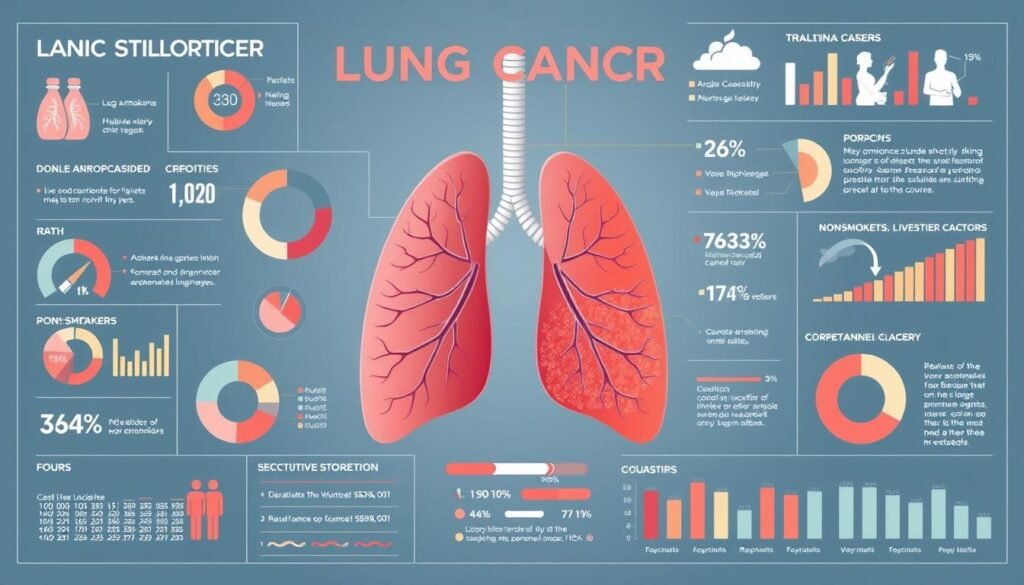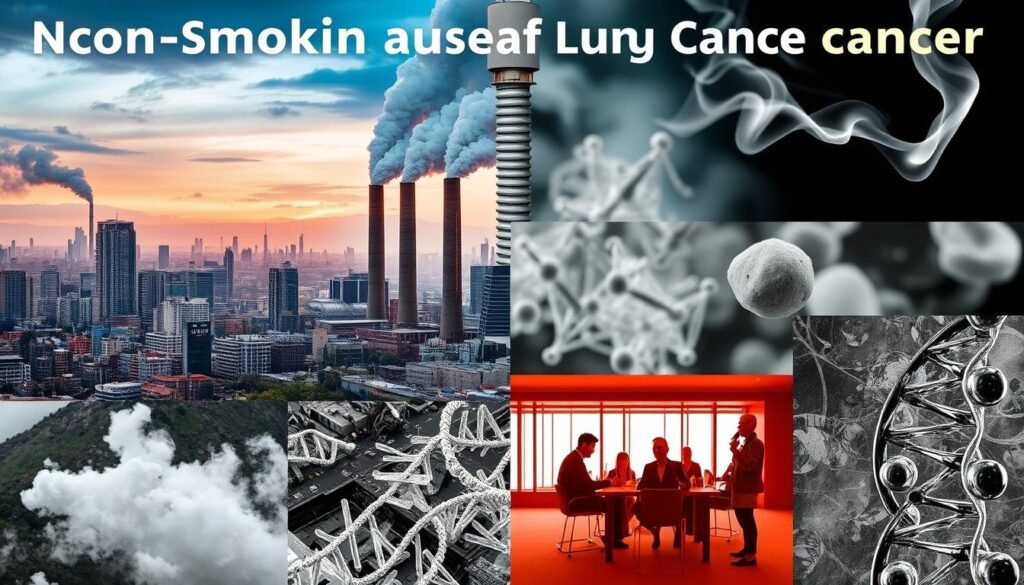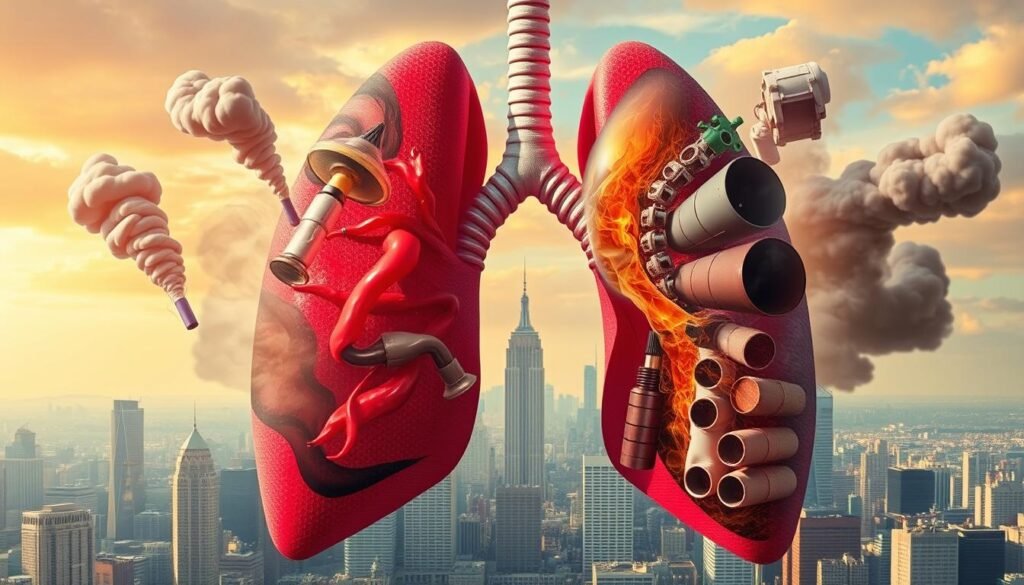In the United States, 20,000 to 40,000 cases of lung cancer occur yearly among those who’ve never smoked much. This highlights a lesser-known fact: non-smokers can get lung cancer too. Though most think lung cancer comes from smoking, many non-smokers also face this challenge. It’s vital to understand what else can cause lung cancer in non-smokers to raise awareness. Find out more about non-smokers’ lung cancer risks.
Exposure to secondhand smoke, radon gas, air pollution, and genetic risks contribute to lung cancer in non-smokers. Interestingly, about 19% of women and 9% of men with lung cancer in the U.S. never smoked. This raises a big question: Can non-smokers get lung cancer, and what causes it? Let’s explore these important issues and learn more about lung cancer’s complex nature.
Key Takeaways
- Lung cancer affects non-smokers, comprising a significant number of annual cases in the U.S.
- Environmental factors such as radon and secondhand smoke are major contributors to non-smokers’ lung cancer risks.
- Adenocarcinoma is the most common subtype of lung cancer among both smokers and non-smokers.
- Women are more frequently diagnosed with lung cancer than men, even among non-smokers.
- Understanding genetic predispositions may help in assessing lung cancer risks in non-smokers.
The Reality of Lung Cancer in Non-Smokers
Lung cancer in non-smokers is a big public health issue. About 10-15% of all lung cancer cases are in people who never smoked. This leads to 16,000-24,000 deaths every year in the U.S. It shows that even non-smokers can face serious health risks from lung cancer.
Lung cancer wasn’t common in North America and Europe before cigarettes became popular. Now, lung cancer among never-smokers is going up. In the UK, cases rose from 13% to 28% between 2008 and 2014.
Studies show that lung cancer risk increases with age for both smokers and non-smokers. Men are generally more likely to die from lung cancer than women, no matter if they smoked or not. This highlights the need for better awareness about lung cancer risks in non-smokers.
Understanding the Statistics of Lung Cancer
Lung cancer statistics shed light on its impact among non-smokers. In the U.S., about 12% of lung cancer patients have never smoked. There’s been an increase in cases among non-smokers over time. For instance, a study of over 12,000 patients found that 14.9% were never-smokers from 2011 to 2013. This is up from just 8% between 1990 and 1995.
Never-smokers, especially women, face a higher risk of lung cancer. Women non-smokers are twice as likely to get lung cancer compared to men. Around 20% of women and 9% of men with lung cancer are never-smokers. This highlights a significant demographic change.
Adenocarcinoma is the main type of lung cancer in non-smokers, making up 50% to 60% of cases. This fact is important as it shows the seriousness of lung cancer among non-smokers. Even as smoking has decreased in the U.S., non-smoking lung cancer rates are rising.

Lung cancer is complex and is not just caused by smoking. Things like the environment, genes, and exposure to radon or secondhand smoke play a big role. There’s a pressing need for more research and funding to face lung cancer head-on. This is especially true for those not covered enough by current studies.
Non-Smoking Causes of Lung Cancer
Lung cancer does not only affect smokers. About 10-20% of lung cancer cases are in non-smokers. It’s important to know the risk factors that aren’t related to smoking.
Exposure to radon, an invisible, odorless gas, is one major risk. This gas comes from uranium in soil and rocks. Places like Portland have high radon levels, raising the lung cancer risk for people there. Breathing in air pollution over time also can damage DNA, increasing the chance of getting lung cancer.
Breathing in secondhand smoke causes over 7,300 lung cancer deaths in the U.S. each year. Living with smokers or being around tobacco smoke often puts non-smokers at risk too. Also, if lung cancer runs in your family, you might have a higher chance of getting it due to inherited gene changes.

Inhaling asbestos and benzene is also dangerous. These are cancer-causing substances. About 8 percent of lung cancers come from genetic factors. This shows that non-smoking risks are a big part of lung cancer cases.
Knowing about these non-smoking causes is crucial. It highlights how important a healthy lifestyle is. Plus, avoiding known cancer-causing agents can lower lung cancer risks. Understanding these risks can help people protect themselves.
Can You Get Lung Cancer Without Smoking
Yes, people who’ve never smoked can still get lung cancer. Knowing the different risk factors is key. It shows us that smoking isn’t the only cause of lung cancer. Non-smokers might face dangers from things like pollution, secondhand smoke, or genes that increase their risk.
Overview of Risk Factors
There are many risks for non-smokers, such as:
- Radon exposure: It’s the second top cause of lung cancer in the U.S. Radon is a big risk for everyone, especially non-smokers.
- Secondhand smoke: Each year, secondhand smoke kills about 7,000 adults. It’s full of bad chemicals.
- Air pollution: Living close to busy roads ups your risk because of the pollutants.
- Asbestos exposure: Asbestos can make lung cancer more likely. Its fibers stick in the lungs.
- Genetic predisposition: Some genes, like those on chromosome 6, might make you more prone to lung cancer.
Prevalence Among Non-Smokers
Lung cancer in non-smokers is more common than you might think. Between 10% and 20% of those with lung cancer never smoked. This is often more the case for women, who get lung cancer younger than smokers do. A study looked at 232 non-smokers with lung cancer. They found different tumor types, like adenocarcinomas.
Interestingly, the study found three new lung cancer types in non-smokers. Each type grows differently and has unique genes. Some grow slowly with few mutations, while others grow fast and have distinct genetic changes.

Environmental Causes of Lung Cancer
Environmental factors play a big role in non-smokers getting lung cancer. Things like radon gas and secondhand smoke are key causes. It’s vital to know about these to raise awareness and push for ways to prevent it.
Impact of Radon Exposure
Radon is an invisible, odorless radioactive gas from the natural breakdown of uranium in soil and rock. It’s hard to find without special tests. Radon exposure causes about 21,000 lung cancer deaths each year in the US. It’s the second main cause of lung cancer.
In some places, like Iowa, the situation is worrying. Seven out of ten homes have radon levels above the safe limit set by the EPA. That’s why testing for radon is crucial.
Secondhand Smoke Risks
Secondhand smoke is also a major risk, causing around 7,000 lung cancer deaths every year. This smoke has over 7,000 chemicals, including many that cause cancer. People exposed to it at work, home, or in public can get lung cancer, even if they’ve never smoked.
Knowing the risks of secondhand smoke is important. So is supporting laws for smoke-free places. These steps are key to reducing lung cancer from secondhand smoke.
| Environmental Factor | Impact | Statistics |
|---|---|---|
| Radon | Second leading cause of lung cancer | Approximately 21,000 deaths annually |
| Secondhand Smoke | Contributes to lung cancer deaths | About 7,000 deaths annually |
| Homes Exceeding Safe Radon Levels | High risk of radon exposure | 70% of homes in Iowa |
Genetic Factors in Lung Cancer
Genetic factors are key in lung cancer development, especially for non-smokers. While most lung cancer cases are linked to smoking, a notable fraction occurs in those who’ve never smoked. This highlights the role of genetic factors in lung cancer for these individuals.
Having a family history of lung cancer increases one’s risk. This fact underlines the relevance of recognizing hereditary lung cancer risks. Studies show that gene mutations are common in non-smokers with lung cancer. For example, around 10% of non-small-cell lung cancer (NSCLC) patients have changes in the EGFR gene. Meanwhile, 25% show mutations in the KRAS gene. These gene mutations in lung cancer affect how tumors grow and respond to treatment.
A study explored tumors from 232 lung cancer patients who never smoked. It found different lung cancer types, including a frequent “piano” subtype in non-smokers. “Piano” tumors had fewer mutations and longer telomeres. This suggests they evolve differently from the “mezzo-forte” and “forte” types. These findings could lead to unique treatment options.
Though smoking is a major lung cancer cause, genetics also greatly influence non-smokers’ risk. Ongoing research into hereditary lung cancer risks and gene mutations in lung cancer promises more tailored treatment and prevention methods ahead.
Lung Cancer Prevention Strategies
Lung cancer prevention is multifaceted, emphasizing reducing exposure to carcinogens and living healthier. It involves staying away from radon-rich places and harmful air substances. Avoiding these can significantly lower lung cancer risks from daily environments.
Eating balanced meals is key for lung health. Adding fruits and cruciferous vegetables like broccoli to your diet is beneficial. Also, regular doctor visits and being mindful of symptoms like continuous coughing or sudden weight loss are crucial. It helps with early detection and getting medical advice on time.
The following table highlights critical lung cancer prevention strategies for non-smokers:
| Prevention Strategy | Description |
|---|---|
| Avoiding Carcinogens | Steering clear of radon, asbestos, and secondhand smoke can mitigate lung cancer risk. |
| Healthy Diet | A diet high in fruits and vegetables, especially cruciferous vegetables, may reduce risk. |
| Regular Check-Ups | Consistent medical evaluations can help identify early signs of lung cancer. |
| Smoke-Free Environment | Creating a smoke-free space helps minimize exposure to harmful tobacco smoke. |
| Physical Activity | Engaging in regular physical activity has potential benefits in lowering lung cancer risk. |
| Awareness of Symptoms | Recognizing signs such as chest pain or persistent cough can prompt early diagnosis. |
Awareness and Advocacy for Lung Cancer
Talking about lung cancer is very important. This is especially true for non-smokers who might not know their risks. The American Lung Association helps a lot with their LUNG FORCE initiative. They work hard to make more people aware of lung cancer and to share stories of those who are affected. Their efforts help change policies and increase funding for research. This is crucial for the health of our lungs.
The way people view lung cancer can make patients feel alone. This stigma might stop them from getting the help they need. Education helps by highlighting various risk factors like secondhand smoke, dirty air, and family history. It’s vital to teach everyone about these risks to fight the stigma.
New laws, like the Katherine’s Lung Cancer Early Detection and Survival Act of 2021, aim to broaden screening access. They want to catch the cancer early in many more people, even if they never smoked. Efforts don’t stop there. There’s also a resolution to make November the National Lung Cancer Awareness Month. This shows a deep commitment to fighting lung cancer.
| Legislation | Description |
|---|---|
| Katherine’s Lung Cancer Early Detection and Survival Act | Extends lung cancer screening coverage to those over 80 and individuals who quit smoking more than 15 years ago. |
| Children’s Product Warning Label Act | Amends regulations to include warnings for children’s products containing talc, related to lung cancer. |
| Protecting American Lungs and Reversing the Youth Tobacco Epidemic Act | Regulates tobacco products to enhance lung health. |
| Veteran’s Right to Breathe Act | Offers healthcare benefits to veterans exposed to burn pits with lung-related conditions. |
| Women and Lung Cancer Research and Preventive Services Act | Promotes research and prevention focused on lung cancer in women. |
By working together for lung cancer advocacy and campaigns, we can learn a lot about the risks for non-smokers. Teaching people and encouraging regular screenings are key steps. Everyone coming together is necessary to beat lung cancer. Supporting lung health is something we should all do.
To get more info on lung cancer awareness, check out these campaigns. They help people understand lung cancer better.
Conclusion
Lung cancer is a big problem for non-smokers too, not just for those who use tobacco. More than 20,000 non-smokers in the United States could die from lung cancer in 2023. This shows that lung cancer in non-smokers is a serious issue that needs our attention.
We need to understand the main points about lung cancer to fight it better. Public health strategies must focus on all risks related to lung cancer. Working together in research and spreading the word is key. This is especially true since two-thirds of non-smoker lung cancer patients are women. So, we must focus on making them more aware.
Lung cancer affects many, not just smokers. It requires us to be well-informed on how to prevent it and catch it early. People should watch out for symptoms and talk to doctors if they’re at risk. To learn more about the importance of early checking, click here. By increasing awareness, we can reduce lung cancer’s impact on non-smokers.